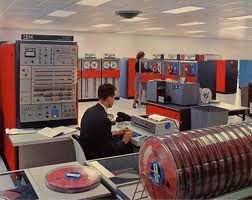Here are our Apple posts concatenated into one story (finally) (this is modern writing, so we start asynchronously):
Act II. Somewhere in 1978 or 79, the Amsterdam department store
De Bijenkorff opened a new sales corner on its 4th floor, mysteriously named "huiscomputers," which featured a new product, the
Apple II home computer. At that time most people, including myself, would conceive of computers as "electronic brains" (Germans called them "Elektronengehirne" before they called them "computers" before they called them "Rechner"), all built by
IBM, all infinitely expensive, large, and remote.
 |
| Standard IBM Hollerith punch card |
Act I. My first contact with computers had been in 1972, when I took an algebra class at the
Free University of Berlin and was tasked to program
matrix inversions and some such in Algol68, the programming language
du jour. This was done by (1) punching Hollerith cards in the right places, on special machines located in the university's computing center, then (2) placing the cards in the intray located in the hallway outside the main operating room where the computer was located (there was only one computer), (3) waiting for an operator to appear to empty the intray (he would open a wing door, and allow you a glimpse at the electronic brain, humming and chugging along in fluorescent light, tape decks clicking back and forth), (4) then waiting another hour or so for the operator to reappear with the "output," --- folded stacks of paper in a very large format, the name of the "job" (no pun intended) printed in very large letters on the first page. If your stack was very thin (as it usually was) this could mean only one thing: something had gone wrong. You would (5) try to find the error, or try to find some help to find the error, (6) correct it, (7) resubmit your job, and repeat the correction loop
as appropriate. Usually, it would take only a few days
until a program of a few lines of code would finally run properly.
 |
| IBM mainframe, system 360 (1964 - 78) |
Act II, cont'd.
So far so good. Back to the department store. What could you do with a home computer, I asked the sales person. Well, he said, you could store cooking recipes and call them up when needed. I didn't buy the Apple II.













